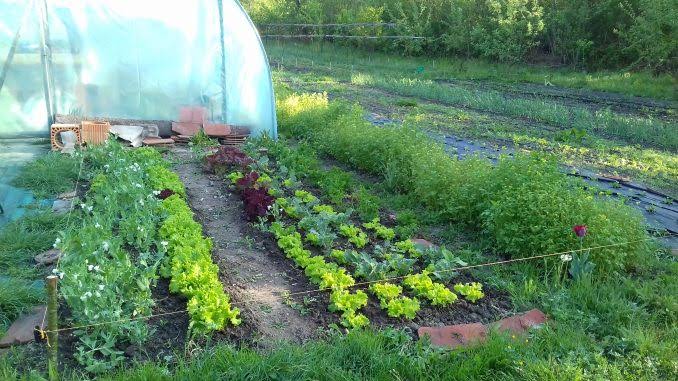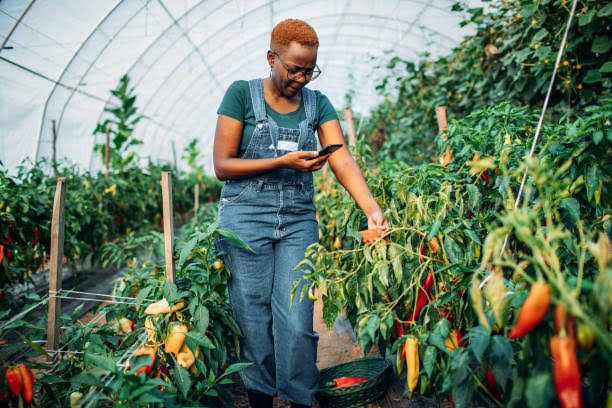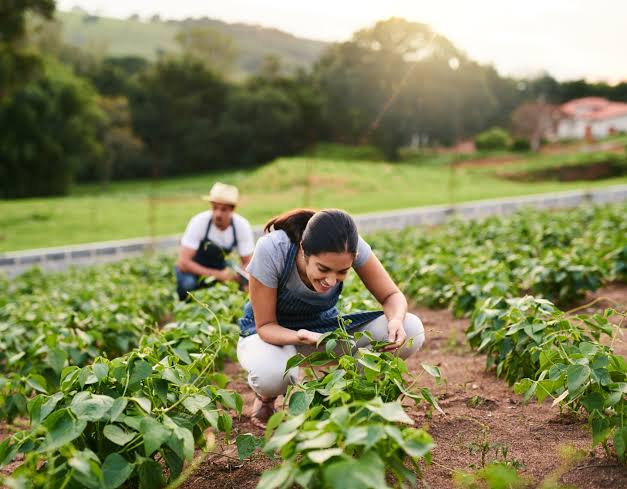Small-scale farming on limited land means making the most of what you have. It could be a tiny backyard, a few pots on a balcony, or a community garden plot. The primary goal is to maximize efficiency and yield in these constrained spaces.
One key aspect of small-scale farming is choosing the right crops. Since space is limited, it’s crucial to focus on high-yielding and space-efficient plants. Vegetables like tomatoes, peppers, and cucumbers are great choices as they can be grown vertically. This means they can climb trellises or be trained to grow upward, making use of the vertical space.
Additionally, herbs and microgreens are excellent options for small-scale farming. These small plants can be grown in pots or small containers, and they provide a quick harvest. Basil, mint, and cilantro are popular choices and can be easily grown on a windowsill.
Soil quality is another critical factor. Small-scale farmers should invest in good-quality soil and enrich it with compost to ensure the crops receive the necessary nutrients. It’s essential to practice crop rotation and avoid overcrowding to prevent diseases and maximize yields.
Water management is equally important. Limited space often means limited access to water sources. Drip irrigation systems or soaker hoses can help deliver water directly to the plants’ roots, reducing wastage and ensuring the plants receive adequate hydration.
Furthermore, small-scale farmers should pay attention to their microenvironment. In urban areas, pollution and limited sunlight can affect plant growth. Positioning plants strategically to receive the optimal amount of sunlight and using barriers to shield them from pollution can make a significant difference.
One of the advantages of small-scale farming is the ability to experiment with different techniques. For example, raised bed gardening is a popular method among small-scale farmers. It provides better control over the soil, reduces weed growth, and extends the growing season. Container gardening is another option, allowing you to move plants as needed to maximize sunlight exposure.
Small-scale farming on limited land also presents an opportunity to use organic and sustainable farming practices. Since the space is smaller, it’s often easier to avoid the use of chemical pesticides and fertilizers. Companion planting, where compatible plants are grown together to deter pests and encourage growth, can be employed effectively in small spaces.
Additionally, small-scale farmers can explore composting to reduce waste and create nutrient-rich soil. Worm composting, known as vermicomposting, can be done in compact containers and provides an excellent source of organic fertilizer.
In addition, small-scale farming on limited land is a promising and viable way to grow your own food and contribute to a sustainable lifestyle. It may require creativity, dedication, and some trial and error, but the rewards of fresh, homegrown produce and the satisfaction of working with nature in a limited space make it a worthwhile endeavor. Whether you have a small backyard, a balcony, or even just a sunny windowsill, you can embark on a small-scale farming journey that brings the joy of agriculture into your life.
Read Also: Practical Feeding Guide for Goat Production
How to start a Small-Scale Farm on Limited Land

Starting a small-scale farm on limited land is an exciting and rewarding venture. Here are some steps to help you get started:
1. Assess Your Space: First, take a close look at the available space. Measure the area, observe the amount of sunlight it receives, and note any potential challenges, such as shade from nearby buildings or trees.
2. Choose Your Crops: Decide what you want to grow based on your space, climate, and personal preferences. Focus on high-yield, space-efficient crops like tomatoes, peppers, cucumbers, herbs, and microgreens. Consider local and seasonal factors as well.
3. Prepare the Soil: Invest in good-quality soil, and if necessary, improve it with compost. Raised beds or containers can help you have more control over the soil conditions. Ensure proper drainage to prevent waterlogged roots.
4. Plan Your Layout: Sketch a rough layout of your small-scale farm. Optimize space by using vertical gardening techniques, trellises, and container gardening. Consider companion planting to deter pests and improve crop growth.
5. Obtain Seeds or Seedlings: Depending on your chosen crops, acquire the appropriate seeds or seedlings from a reliable source. Pay attention to plant spacing and timing for each crop.
6. Planting: Follow the instructions on your seed packets or consult local gardening resources for planting guidelines. Ensure your crops are well-spaced and adequately watered. Using a drip irrigation system or soaker hoses can help conserve water.
7. Maintenance: Regularly check your crops for signs of pests or disease. Implement organic pest control methods, like introducing beneficial insects or using neem oil. Keep up with weeding and thinning to prevent overcrowding.
8. Harvesting: Harvest your crops when they reach the appropriate size and maturity. For herbs and microgreens, continuous harvesting can promote further growth. Be gentle when harvesting to avoid damaging the plants.
9. Compost and Fertilize: Implement composting to reduce waste and create nutrient-rich soil. Consider vermicomposting (worm composting) for small-scale farms. Use organic fertilizers to enrich the soil as needed.
10. Record Keeping: Maintain a gardening journal to record planting dates, varieties, and any observations about your crops. This will help you learn from your experiences and plan for future seasons.
11. Continuous Learning: Stay informed about gardening and farming practices. Attend workshops, read books, or join local gardening clubs to exchange ideas and tips with fellow gardeners.
12. Community Involvement: If you’re part of a community garden or have limited land, collaborate with neighbors or fellow gardeners. Sharing resources and knowledge can be mutually beneficial.
13. Enjoy the Process: Remember that small-scale farming on limited land is not just about the harvest; it’s also about the journey. Enjoy the connection with nature, the satisfaction of growing your own food, and the benefits of a healthier, more sustainable lifestyle.
Starting a small-scale farm on limited land may take some time and experimentation, but with dedication and a bit of creativity, you can turn your limited space into a productive and fulfilling mini-farm.
Read Also: Feeding and Grazing Behaviour of Goats
Benefits of Starting a Small-Scale Farm on Limited Land

Starting a small-scale farm on limited land comes with a range of benefits, both for the environment and for those engaged in the practice. Here are some of the key advantages:
1. Fresh, Homegrown Produce: One of the most significant benefits is having access to fresh, organic produce right at your doorstep. You can enjoy the taste and nutritional value of fruits and vegetables harvested at their peak ripeness.
2. Reduced Environmental Impact: Small-scale farming often encourages the use of sustainable and organic practices, which are kinder to the environment. This includes reduced chemical usage, composting, and responsible water management.
3. Space Efficiency: Limited land space can be maximized through techniques like vertical gardening and container farming. This allows for a higher yield per square foot, making the most of your available area.
4. Cost Savings: Growing your own food can help you save money on groceries. Plus, it reduces the carbon footprint associated with transporting produce from distant locations.
5. Control Over Food Quality: You have control over the quality of the soil, water, and nutrients used in your small-scale farm. This means you can grow your food without harmful chemicals and pesticides.
6. Educational Opportunity: Small-scale farming offers an excellent educational experience. You can learn about plant life cycles, ecosystems, and sustainable agriculture. It’s a hands-on way to connect with nature and gain practical knowledge.
7. Mental Health Benefits: Gardening and farming have been shown to have positive effects on mental well-being. Being in contact with nature, engaging in physical activity, and witnessing the growth of plants can reduce stress and improve mental health.
8. Community Building: If you participate in a community garden or share your small-scale farm produce with neighbors, it can foster a sense of community and cooperation.
9. Self-Sufficiency: Producing your food empowers you to be more self-sufficient and less reliant on commercial food sources. It can also serve as a backup in case of food supply disruptions.
10. Reduced Food Waste: You can harvest only what you need, reducing food waste. Any excess can be shared with friends, family, or local food banks.
11. Aesthetic Beauty: A well-maintained small-scale farm can enhance the visual appeal of your property. Lush plants and flowers can make your limited land more beautiful.
12. Conservation of Biodiversity: By growing a variety of crops, you contribute to biodiversity and the preservation of heirloom and native plant species.
13. Economic Opportunities: If you choose to sell your surplus produce, it can become a small source of income. You can also explore niche markets or local farmers’ markets.
14. Food Security: Having a small-scale farm ensures a degree of food security, as you are less vulnerable to external factors that affect the food supply chain.
In summary, small-scale farming on limited land is a sustainable, rewarding, and environmentally responsible practice that offers numerous benefits. It allows you to enjoy fresh, homegrown food while contributing to a more resilient and eco-friendly food system.

